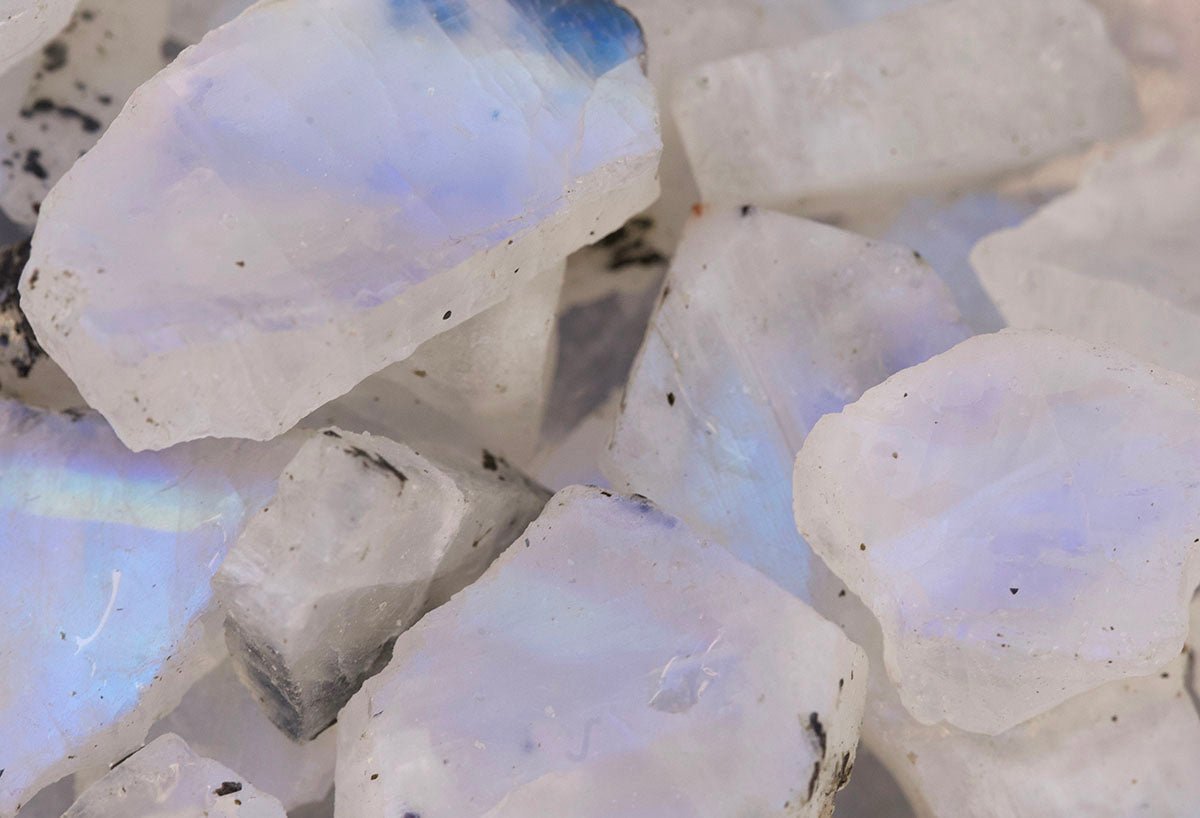
Rainbow Moonstone Meaning, Properties and Uses
Upon first glance, these gorgeous gems can be difficult to distinguish from 'proper' moonstone, however, rainbow moonstone is actually a variety of labradorite.

Rainbow moonstone and moonstone are both types of feldspar and while similar in appearance, they do share differing properties. Both rainbow moonstone and blue moonstone have predominantly blue flashes. However, rainbow moonstone also can show other colors such as yellow, orange and purple.
The colors vary depending on mineral inclusions, though all rainbow moonstones have a property known as 'adularescence'. This is the fancy technical term for that gorgeous shimmering iridescent glow which seems to emanate from within the gem itself.
This glow can be blueish, though it will often appear to take on the full color spectrum, hence the 'rainbow' moniker. This glorious glimmer gives an ethereal mystique to the already pretty gemstone, adding an aura of divinity and powerful feminine charm and has been loved by humans the world over since record-keeping began!
Rainbow Moonstone Meaning
The etymology of the name 'rainbow moonstone' is interesting. Firstly, rainbow moonstone is not the same as blue moonstone. White labradorite is an alternate name for rainbow moonstone.
Labradorite belongs to the mineral family called feldspar, which is a one of the most plentiful and abundant minerals on earth, making up almost half of the Earth's crust. Labradorite takes its name from Labrador, Canada, where it was first discovered.

Despite the differences, to the naked eye, there is seemingly very little in the difference between rainbow moonstone and blue moonstone. The rainbow iridescent effect that light has on white labradorite is due to a property called 'adularescence', which takes its name from the word 'adularia', an antiquated name for rainbow moonstone, which comes from Mount Adular (now St Gotthard) in Switzerland, which was once a site for mining high quality rainbow moonstone.
Rainbow Moonstone History
The glimmering sheen that sets rainbow moonstone apart was once adored by the ancient Romans, Greeks and Hindu cultures, who believed that moonbeams were solidified or trapped within the moonstone.
They associated rainbow moonstone (and moonstone more broadly) with all things lunar and feminine, such as fertility, compassion and harmony. A lot of the folklore and history of rainbow moonstone overlaps with moonstone, because lapidaries only recently began to distinguish between the two of them now that we have more refined methods of identification and classification.

The Art Nouveau scene really took a liking to rainbow moonstone, with famous designers including moonstone among some of their most treasured pieces, particularly designers like Louis Comfort Tiffany and René Lalique. In the latter half of the 20th century, the Hippie/Flower Child movement also took a shine to rainbow moonstone!
Drawing on all the same themes of compassion, nature, healing and divinity, rainbow moonstone was the perfect gemstone to represent their style. Since then, any Hippie-inspired fashion designer pays homage to the era by including moonstones as part of their look, such as the 'New Age' movement popularized in the 1990s/2000s.
Rainbow Moonstone Properties
Rainbow moonstone belongs to the family called feldspar, meaning it is a tectosillicate usually containing potassium, barium, sodium or calcium. Feldspars form as a magma begins to cool, harden and crystallize. This magma in this case is then an orthoclase.
Orthoclase is a mineral which was discovered in 1801 by R.J. Hauy and was named after the Greek term meaning 'Straight Fracture', due to the right-angled planes of its double cleavage.
Orthoclase can be found in igneous rocks which are intrusive (such as granite) or extrusive (such as dacite).

Orthoclase crystals are found in pegmatite, ordinarily no larger than a couple of inches, though one example from the Ural mountains was a staggering 100 tons in weight and 30 foot in length!
As the magma cools and crystallizes, different layers are created, which disperse and scatter the light inside, creating that 'glowing' effect (adularesence) which changes as the observer moves the stone around, often dancing in the light and creating a beautiful refraction, mimicking the rainbow.
Where Is Rainbow Moonstone Found?
Rainbow moonstone can be mined the world over. It is found in Sri Lanka, Switzerland, United States, Tanzania, Italy, Spain, Russia and more!

Rainbow Moonstone Metaphysical Properties
The metaphysical properties associated with rainbow moonstone are all things lunar and the 'divine feminine'. The associated traits of 'divine femininity' are intuition, healing, spiritual protection, soothing as well as promoting balance and harmony in one's life.
Rainbow moonstone is believed by some to foster emotional healing and a sense of joy. It has also been favored by those embarking on journeys and seeking guidance and protection, warding off negative energies and vibrations.
To get your own unique piece of jewelry made from rainbow moonstone, check out our made to order section here.



